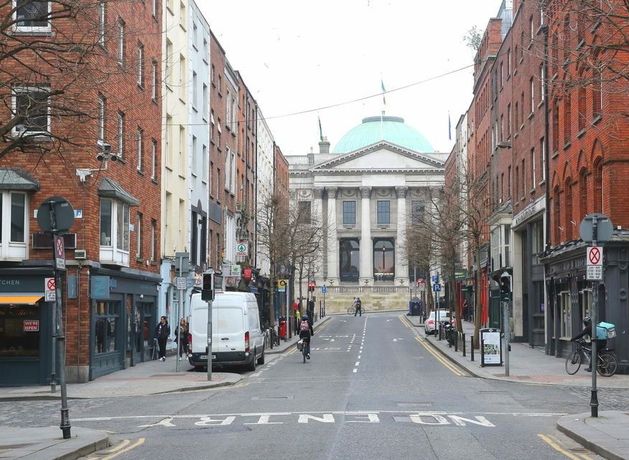The measure confirmed by Dublin City Council is due to come into effect in late June, following a two-week public consultation process that launched today.
The public consultation invites feedback from residents, businesses and the wider public on the proposed changes, which include new cycling routes and improved pedestrian spaces.
The proposal, now open for non-statutory public consultation, will see Parliament Street – which connects the south quays to Dame Street – reallocated exclusively for walking and cycling for most of the day.
Greening, seating and public realm enhancements are also planned to make the street more attractive for pedestrians and cyclists.
According to Dublin City Council’s traffic management unit, currently almost 90pc of people using Parliament Street are either walking or cycling.
Under the plans the section between Essex Quay and Essex Gate will be permanently traffic-free, with the road raised to footpath level.
Today’s News in 90 Seconds – May 13th
The stretch between Essex Gate and Lord Edward Street will also be traffic-free, but deliveries and local access will be permitted between 6am and 11am daily.
The current west-to-east flow between Essex Gate and Essex Street East will remain open to all traffic at all times and two-way cycling will be permitted on Parliament Street.
The council says the new layout will support that existing demand while creating a “safer and more pleasant environment in the city centre”.
The move follows the success of the pedestrianisation of nearby Capel Street on the north side of the river, and the introduction of car restrictions along the Liffey quays last year.
The quays measures, which banned private vehicles from travelling east or west at O’Connell Bridge between 7am and 7pm, resulted in faster and more reliable bus journey times and increased bus throughput on key routes.
Brendan O’Brien, head of traffic at Dublin City Council, previously spoke at the monthly council meeting in April and said there was “a lot of support” on Parliament Street itself for making it traffic-free.
“What we’re in essence proposing to do is in the first place to remove some of the car traffic, to allow deliveries up to 11am, and, as the street settles down into a new pattern, which is very closely aligned with the type of street furniture and so on that we have in Capel Street over a period of time we’ll solidify the arrangements,” he said
The plan also includes a new two-way cycling route on the east side of Grattan Bridge, reducing the bridge to a single right-turn lane for traffic.
A linked two-way cycle path will run up Capel Street to complete a continuous cycling corridor from Bolton Street on the northside to Dame Street on the southside.
The only remaining barrier to pedestrianising Parliament Street — the number 69 bus — is expected to be eliminated under the National Transport Authority’s redesign of Dublin’s bus network, clearing the way for the plan to proceed.
Following the consultation, feedback will be assessed in June and interim arrangements will be introduced in July and August, alongside a programme of summer events to activate the space.
A full review of the pilot scheme will be presented to councillors at the end of the year.
This measure is part of the wider Dublin City Centre Transport Plan 2023, which aims to prioritise public transport, walking and cycling while reducing private car dominance.
Other upcoming measures include traffic restrictions at Pearse Street, and design work for civic plazas at College Green and possibly Beresford Place near the Custom House.
The consultation on Parliament Street will run until May 27 and is available on Dublin City Council’s website.
#Parliament #Street #trafficfree #latest #phase #city #transport #plan








